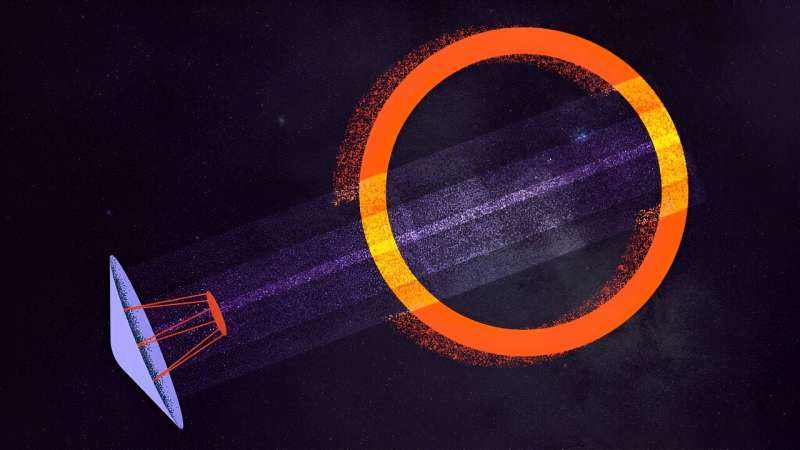This article has been reviewed according to Science X's editorial process and policies. Editors have highlighted the following attributes while ensuring the content's credibility:
fact-checked
trusted source
proofread
After capturing image of black hole, what's next?

A group of international researchers led by the Center for Astrophysics | Harvard and Smithsonian (CfA) achieved the once-unimaginable four years ago: using a groundbreaking telescope to capture an image of a black hole.
Last month some of those researchers, engineers, and physicists convened at Harvard to consider and begin drawing up plans for the next step: a closer study of the photon rings that encircle black holes in glowing orange. The mission has been dubbed the Event Horizon Explorer (EHE), and the group hopes it will offer additional insight into black holes, which sit at the center of galaxies.
The $300 million project examining the nature of space and time builds on the success of the Event Horizon Telescope (EHT) project of 2019, when researchers took the first-ever picture of a black hole, a focal point so tiny "the biggest ones on the sky are only about the same size as an atom held at arm's length," said Michael Johnson, an astrophysicist at the CfA.
"What we are trying to do now is launch a space mission that would improve the sharpness of the EHT images by a factor of 10," Johnson said. This would reveal photon rings—rings made by the light orbiting a black hole. Johnson described these as similar to "a tiered wedding cake, where each time the light goes around, it piles up a sharper ring." Currently, "We can't see those in the EHT images. They're too narrow to distinguish from the rest of the light near a black hole," he said.
It's a huge undertaking, but for the recently gathered team of more than 70 researchers, the project is beginning to look possible. "We were trying to figure out if there were any showstoppers. Was there any reason that we can't launch this within the next 10 years? And the exciting thing was that there weren't," said Janice Houston, a systems engineer at the CfA. "We think that we can keep our foot on the gas and actually get this built within the next decade."
The concept seems drawn from a Hollywood space odyssey. "Detecting the photon ring requires recording huge volumes of data on the spacecraft. We plan on using laser light to beam the information equivalent of the entire Library of Congress down to Earth," said Peter Galison, Joseph Pellegrino University Professor in the History of Science and Physics and director of Harvard's Black Hole Initiative.
However, the payoff could be hard proof of what once seemed impossible. Photon rings, for example, would provide proof that black holes at the centers of galaxies are spinning, and that they are dragging their space-time along with them as they rotate. Space-time is a mathematical model that describes the four-dimensional fabric of the cosmos—length, width, height, and time.
"If a black hole is spinning, it would distort the shape of the photon ring, squeezing it into an oval," Galison said. If the EHE is able to measure the photon ring, "that will be a rock-solid measurement of the effects of the rotating black hole to bend the path of light itself."
Before the EHE can launch, it faces immense challenges, from building sensitive receivers that are cooled to nearly absolute zero to record the light hitting the telescope, to launching a dish several meters in diameter with an exquisitely precise surface. "At NASA, we are always pushing the boundaries of engineering to explore entirely new parts of the universe," said Eliad Peretz, a mission and instrument scientist at NASA Goddard Space Flight Center. "This is a chance to bring together breakthrough technologies in many different systems to bring us closer than ever before to seeing the edge of the universe."
Dominic Chang, who is studying physics in Harvard's Griffin Graduate School of Arts and Sciences, is one of the scientists working on the theoretical physics driving the project. For the last two years, he's been building physics-based models that "are quick to compute and can be fit to data to describe what's happening in the 3D geometry of the space-time." During the workshop, Chang focused on science applications for the EHE, coming up with proposals that engineers would be able to reasonably construct.
"Basically, we wanted to come up with a set of ideas that we knew we could support with lots of simulations. And the workshop led to a flurry of new ideas. It's amazing to be part of this project on the ground floor and to contribute to the burst of progress that is tied to a potential new experiment," Chang said.
"This mission would have profound implications for multiple priority areas identified by the U.S. astronomy community in the last decadal survey," said Peter Kurczynski, chief scientist of cosmic origins at NASA Goddard. "This is an extraordinary opportunity for us to finally understand how the enormous black holes in the centers of galaxies actually formed."
FAS Dean of Science Christopher Stubbs addressed the workshop on one of its early days, giving the team guidance in a talk called "Going Big: A Scientist's Guide to Big Projects and Large Collaborations."
"It's remarkable that this group, along with others, has managed to accomplish the paradoxical thing of imaging a black hole," he said. "Leveraging that and moving forward is significant."
Provided by Harvard University
This story is published courtesy of the Harvard Gazette, Harvard University's official newspaper. For additional university news, visit Harvard.edu.





















